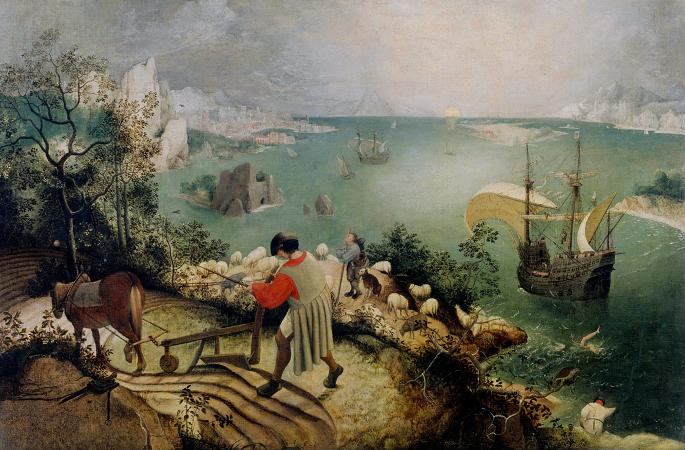Peasant and Birdnester (1568). Oil on panel. 59 x 68. The Peasant and the Nest Robber is an oil-on-panel painting by the Netherlandish Renaissance artist Pieter Bruegel the Elder, painted in 1568. It is in the Kunsthistorisches Museum in Vienna. This painting was in the collections of since 1569; passed on to the imperial collection, it became part of those of the Kunsthistorisches Museum at its inauguration. Painted the year before the artist's death, this painting, like other late works such as The Land of Cockaigne, The Peasant Dance, and The Peasant Wedding, is dominated by monumental figures. Immediately after his return from Italy, Bruegel showed no apparent interest in Italian figure types and compositions, reverting to the Antwerp tradition in which he had been trained. However, in these late works he shows that his study of Italian painting had taken root: these figures demonstrate his knowledge of Italian art and in particular the art of Michelangelo. This unusual subject apparently illustrates a Netherlandish proverb: Dije den nest Weet dijen weeten, dijen Roft dij heeten He who knows where the nest is, has the knowledge, he who robs, has the nest. The painting presents a moralising contrast between the active, wicked individual and the passive man who is virtuous in spite of adversity And lastly it could be suggested that the pointing man is making judgement on the robber whilst not aware that he is nearly stepping into the water in front of him. It has been suggested that, with his knowledge of Italian art, Bruegel intended the peasant's gesture as a profane parody of the gesture of Leonardo's St John see image at left. The Peasant and the Nest Robber at the Kunsthistorisches Museum. Notes on the painting, on Frammenti d'Arte Accessed 4 February 2012. Bosch Bruegel Society. 99 works by Pieter Bruegel the Elder. Creative Bruegel laid the foundation of the Netherlands School. Encyclopedia Americana. 1920. v. t. e. Pieter Bruegel the Elder Paintings List of paintings. Parable of the Sower. The Fight Between Carnival and Lent. Netherlandish Proverbs. Children's Games. Landscape with the Fall of Icarus. The Triumph of Death. The Fall of the Rebel Angels. The Suicide of Saul. Two Monkeys. Dull Gret. The Tower of Babel. Landscape with the Flight into Egypt. The Adoration of the Kings. The Procession to Calvary. Christ and the Woman Taken in Adultery. The Gloomy Day. The Harvesters. The Hay Harvest. The Return of the Herd. The Wine of Saint Martin's Day. The Hunters in the Snow. The Bird Trap. Massacre of the Innocents. The Census at Bethlehem. The Preaching of St John the Baptist. The Wedding Dance. Conversion of Paul. The Land of Cockaigne. The Peasant Wedding. The Peasant Dance. The Beggars. The Peasant and the Nest Robber. The Blind Leading the Blind. The Magpie on the Gallows. The Misanthrope. The Storm at Sea. Related Pieter Brueghel the Younger. Jan Brueghel the Elder. Breugel, Netherlands. Son en Breugel. Bruegel. 9664 Brueghel. Bruegel. Authority control. Categories: 1568 paintings. Paintings by Pieter Brueghel the Elder. Paintings of the Kunsthistorisches Museum. Hidden categories: Articles with Italian-language external links. Commons category link is on Wikidata. Commons category link is locally defined. Wikipedia articles incorporating a citation from the Encyclopedia Americana with a Wikisource reference. Wikipedia articles with GND identifiers. Wikipedia articles with RKDID identifiers. Personal tools Not logged in. Talk. Contributions. Create account. Log in. Namespaces Article. Talk. Views Read. Edit. View history. Search Navigation Main page. Contents. Featured content. Current events. Random article. Donate to Wikipedia. Wikipedia store. Interaction Help. About Wikipedia. Community portal. Recent changes. Contact page. Tools What links here. Related changes. Upload file.
more...




